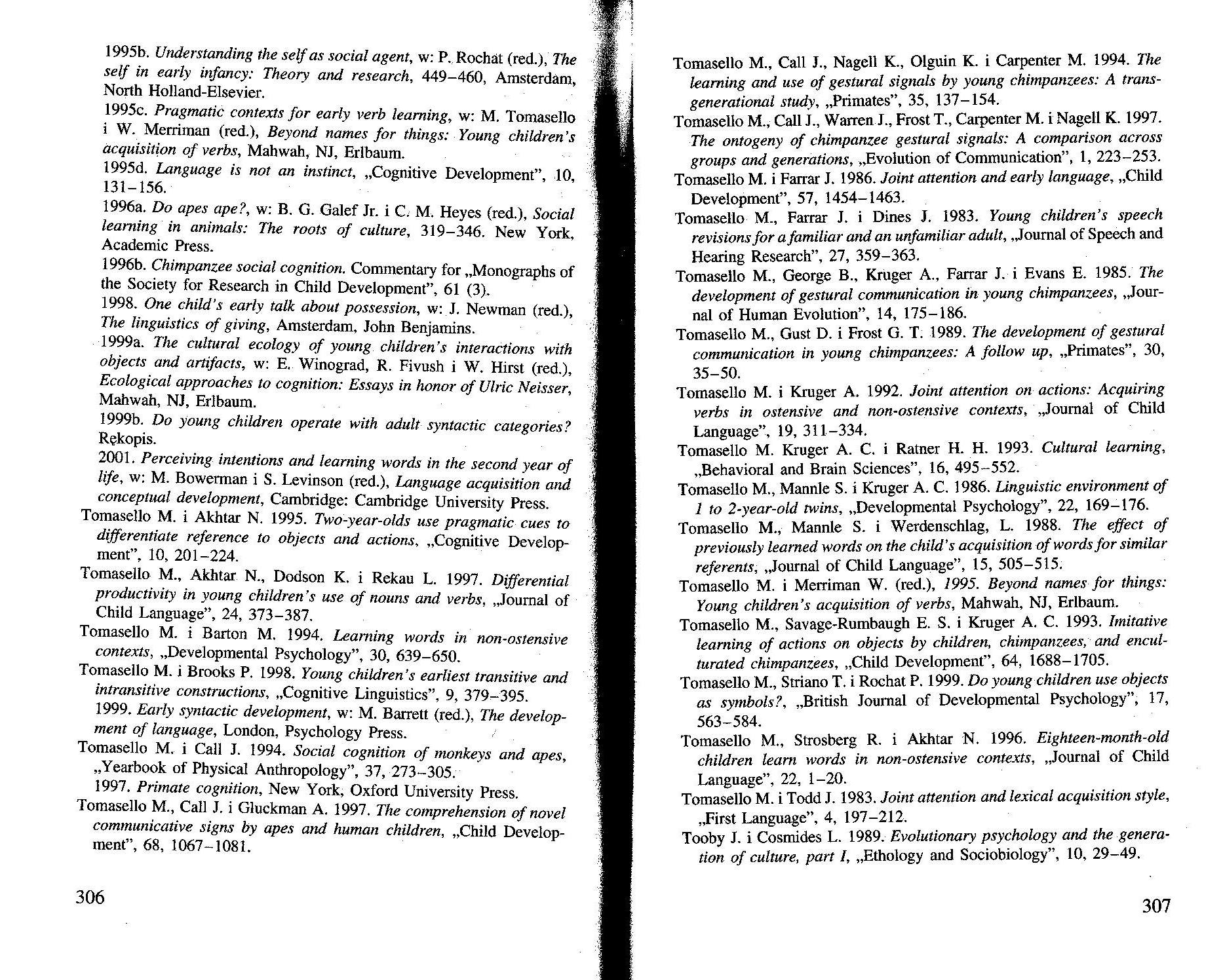CCF20090212�152

1995b. Understanding the self as sociał agent, w: P. Rochat (red.), The sełf in early infancy: Theory and research, 449-460, Amsterdam, North Holland-Elsevier.
1995c. Pragmatic contexts for early verb leaming, w: M. Tomasello i W. Merriman (red.), Beyond names for things: Young children’s acąuisition of verbs, Mahwah, NJ, Erlbaum.
1995d. Language is not an instinct, „Cognitive Development”, 10, 131-156.
1996a. Do apes ape?, w: B. G. Galef Jr. i C. M. Heyes (red.), Social leaming in animals: The roots of culture, 319-346. New York, Academic Press.
1996b. Chimpanzee social cognition. Commentary for „Monographs of the Society for Research in Child Development”, 61 (3).
1998. One child's early talk about possession, w: J. Newman (red.), The linguistics of giving, Amsterdam, John Benjamins.
1999a. The cultural ecology of young children’s interactions with objects and artifacts, w: E. Winograd, R. Fivush i W. Hirst (red.), Ecological approaches to cognition: Essays in honor of Ulric Neisser, Mahwah, NJ, Erlbaum.
1999b. Do young children operate with adult syntactic categories? Rękopis.
2001. Perceiving intentions and learning words in the second year of life, w: M. Bowerman i S. Levinson (red.), Language acąuisition and conceptual development, Cambridge: Cambridge University Press. Tomasello M. i Akhtar N. 1995. Two-year-olds use pragmatic cues to differentiate reference to objects and actions, „Cognitive Develop-ment”, 10, 201-224.
Tomasello M., Akhtar N., Dodson K. i Rekau L. 1997. Differential productivity in young children’s use of nouns and verbs, „Journal of Child Language”, 24, 373-387.
Tomasello M. i Barton M. 1994. Leaming words in non-ostensive contexts, „Developmental Psychology”, 30, 639-650.
Tomasello M. i Brooks P. 1998. Young children’s earliest transitive and intransitive constructions, „Cognitive Linguistics”, 9, 379-395.
1999. Early syntactic development, w: M. Barrett (red.), The develop-ment of language, London, Psychology Press.
Tomasello M. i Cali J. 1994. Social cognition of monkeys and apes, „Yearbook of Physical Anthropology”, 37, 273-305.
1997. Primate cognition, New York, Oxford University Press. Tomasello M., Cali J. i Gluckman A. 1997. The comprehension of novel communicative signs by apes and human children, „Child Develop-ment”, 68, 1067-1081.
Tomasello M., Cali J., Nagell K., Olguin K. i Carpenter M. 1994. The leaming and use of gestural signals by young chimpanzees: A trans-generational study, „Primates”, 35, 137-154.
Tomasello M., Cali J., Warren J., Frost T., Carpenter M. i Nagell K. 1997. The ontogeny of chimpanzee gestural signals: A comparison across groups and generations, „Evołution of Communication”, 1, 223-253.
Tomasello M. i Farrar J. 1986. Joint attention and early language, „Child Development”, 57, 1454-1463.
Tomasello M., Farrar J. i Dines J. 1983. Young children’s speech revisions for afamiliar and an unfamiliar adult, „Journal of Speech and Hearing Research”, 27, 359-363.
Tomasello M., George B., Kruger A., Farrar J. i Evans E. 1985. The development of gestural communication in young chimpanzees, .Journal of Humań Evolution”, 14, 175-186.
Tomasello M., Gust D. i Frost G. T. 1989. The development of gestural communication in young chimpanzees: A follow up, „Primates”, 30, 35-50.
Tomasello M. i Kruger A. 1992. Joint attention on actions: Acąuiring verbs in ostensive and non-ostensive contexts, „Journal of Child Language”, 19, 311-334.
Tomasello M. Kruger A. C. i Ratner H. H. 1993. Cultural leaming, „Behavioral and Brain Sciences”, 16, 495-552.
Tomasello M., Mannie S. i Kruger A. C. 1986. Linguistic environment of 1 to 2-year-old twins, „Developmental Psychology”, 22, 169-176.
Tomasello M., Mannie S. i Werdenschlag, L. 1988. The effect of previously learned words on the child ’s acąuisition of words for similar referents, „Journal of Child Language”, 15, 505-515.
Tomasello M. i Merriman W. (red.), 1995. Beyond names for things: Young children’s acąuisition of verbs, Mahwah, NJ, Erlbaum.
Tomasello M., Savage-Rumbaugh E. S. i Kruger A. C. 1993. Imitative leaming of actions on objects by children, chimpanzees, and encul-turated chimpanzees, „Child Development”, 64, 1688-1705.
Tomasello M., Striano T. i Rochat P. 1999. Do young children use objects as symbols?, „British Journal of Developmental Psychology”, 17, 563-584.
Tomasello M., Strosberg R. i Akhtar N. 1996. Eighteen-month-old children leam words in non-ostensive contexts, „Journal of Child Language”, 22, 1-20.
Tomasello M. i Todd J. 1983. Joint attention and lexical acąuisition style, „First Language”, 4, 197-212.
Tooby J. i Cosmides L. 1989. Evolutionary psychology and the genera-tion of culture, part 1, „Ethology and Sociobiology”, 10, 29-49.
307
Wyszukiwarka
Podobne podstrony:
CCF20090212�149 1995. Understanding the intentions of others: Re-enactment ofintended acts by 18-mon
as (3) Fetting mlght disguise the individual crochet stilches but not the style in these simpły
Slide5 PRODUCE IT See the information in English (or picture) and think or say it in Polish You can
Photo: Humboldt Foundation/Nikolaus Brade From Zeus to the Argonauts: In times past, children and yo
Slide5 PRODUCE IT See the information in English (or picture) and think or say it in Polish You can
Overview of Database Backup and Recovery The focus in Oracle Database backup and recovcry is on the
The legacy and the futurę of the region: How to Prepare for the Revolution in Society. Trade. Servic
TOWARDS A DECARBONISED EU BUILDING STOCK:EXPERT VIEWS ON THE ISSUES AND CHALLENGES FACING THE TRANSI
December 1924 and March 1925 at the universities in Romę, Padua, Florence and Bologna and the Veneti
- Editorial----Epilogue at Stony Brook: The Year in Controversy łt a coming. And it a błg. Finala we
CONTENTS EDITORIAL 11 DĘCI SI ON MA KING: THEORY AND RESEARCH Wojciech Gasparski THE KLEMENS SZANIAW
Social competences: Course content PKO 1 understands the need of self-improvement P_K02 understands
CCF20090225�138 Goffman E„ The Presentation of Self in Everyday Life, Garden City, N.Y., Doubleday &
7 The Role of the Government In this system of Social Partnership, the government has a com-pensator
więcej podobnych podstron